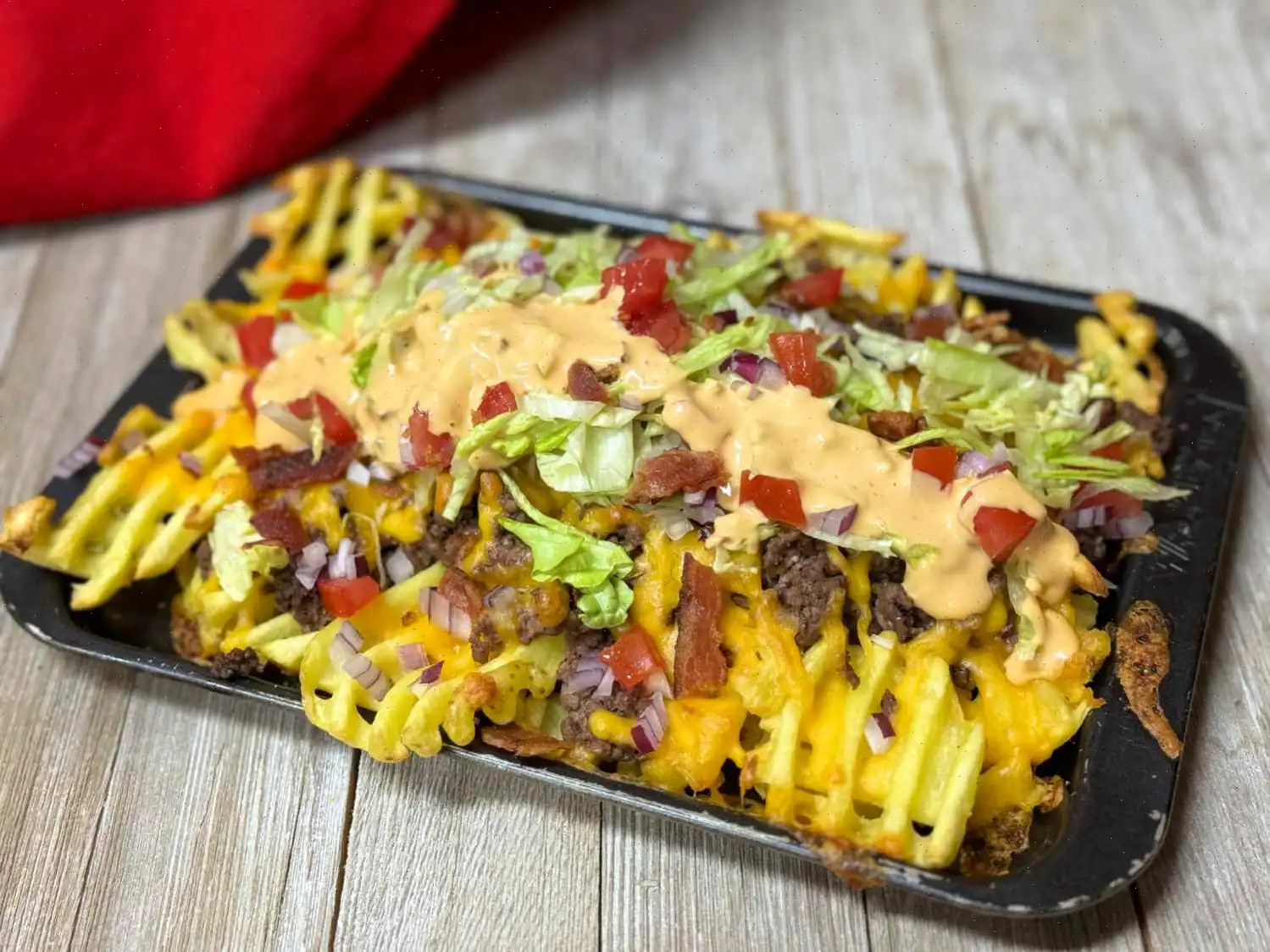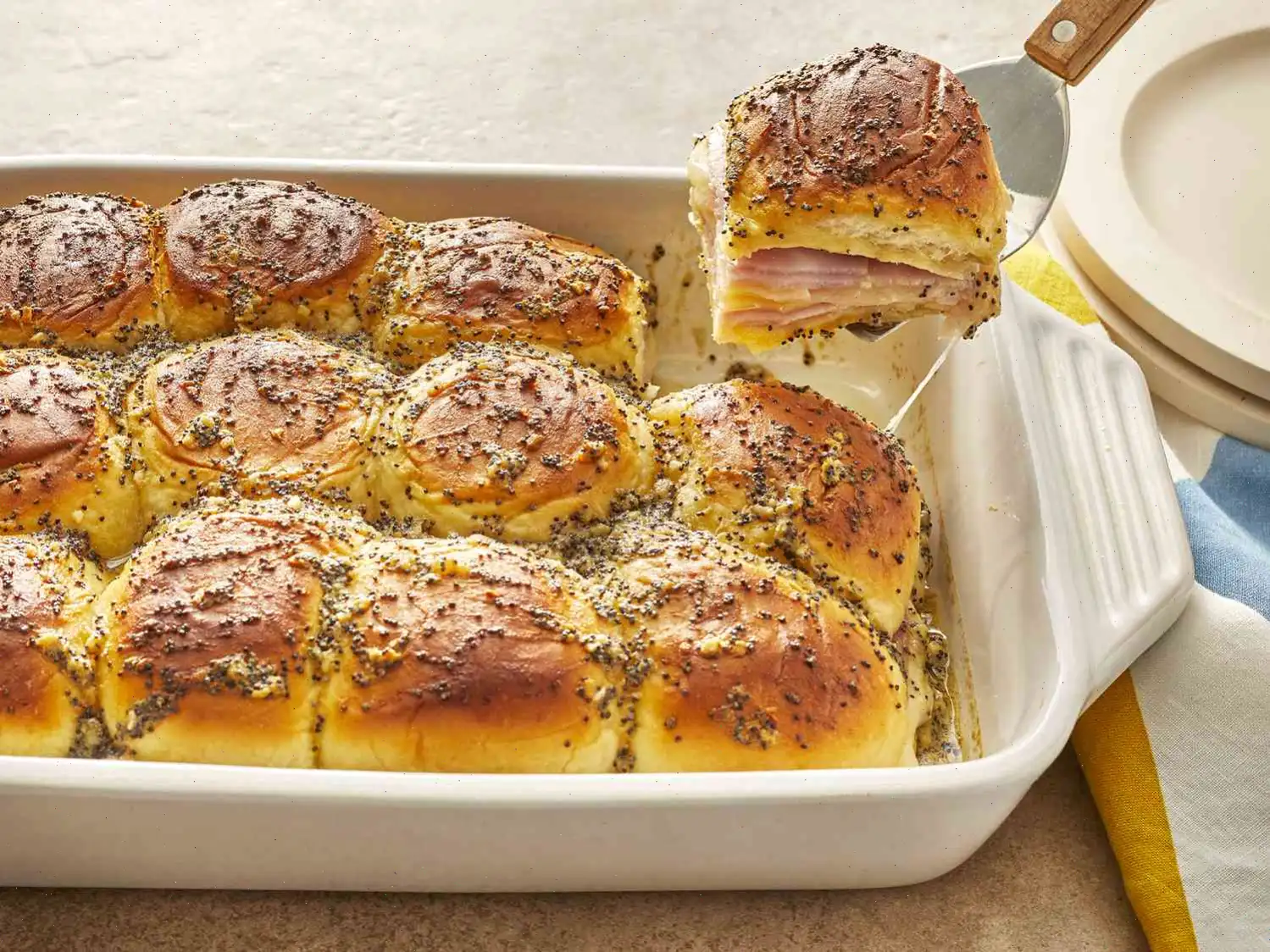
Loaded Waffle Fries Recipe
Ingredients
- 1 tablespoon ketchup
- 1 tablespoon mayonnaise
- 1 teaspoon yellow mustard
- 1 teaspoon dill pickle relish
- 12 ounces frozen waffle fries
- 2 slices thick-cut bacon
- 8 ounces lean ground beef
- 1/2 teaspoon burger seasoning (such as McCormick Grill Mates Worcestershire Pub Burger Seasoning)
- 1 cup shredded Cheddar cheese
- 1 cup shredded lettuce
- 1 Roma tomato, chopped
- 2 tablespoons minced red onion
Directions
Step 1: In a small bowl, whisk together the ketchup, mayonnaise, mustard, and dill pickle relish. Set the sauce aside.
Step 2: Preheat the oven to 425F (220C). Line a baking sheet with foil and arrange the waffle fries in a single layer. Bake the fries for about 20 minutes or according to the package directions, until golden and crispy.
Step 3: While the fries bake, place the bacon in a skillet over medium-high heat. Cook until crisp, about 5 minutes. Transfer the bacon to a paper towel-lined plate and crumble once it cools enough to handle.
Step 4: Using the same skillet, add the ground beef and sprinkle with the Worcestershire pub burger seasoning. Cook and stir the beef over medium-high heat for about 8 minutes, until browned. Drain the beef in a colander.
Step 5: Once the fries are done, divide the cooked beef among them and top with shredded Cheddar cheese. Return the baking sheet to the oven and bake for an additional 5 minutes, or until the cheese is melted.
Step 6: Top the loaded fries with shredded lettuce, chopped tomato, minced red onion, and crumbled bacon. Drizzle the prepared sauce over the top and serve immediately.
Nutrition Facts
| Nutrient | Per Serving |
|---|---|
| Calories | 387 |
| Total Fat | 22g |
| Saturated Fat | 7g |
| Cholesterol | 57mg |
| Sodium | 440mg |
| Total Carbohydrate | 27g |
| Dietary Fiber | 3g |
| Total Sugars | 2g |
| Protein | 19g |
| Vitamin C | 8mg |
| Calcium | 159mg |
| Iron | 2mg |
| Potassium | 639mg |
* Percent Daily Values are based on a 2,000-calorie diet. Your daily values may be higher or lower depending on your calorie needs.
Loaded waffle fries are a beloved American dish, often served as an appetizer or a side dish at casual dining spots, pubs, and even at home during game days. This dish combines crispy, golden waffle fries with an indulgent topping of seasoned beef, bacon, melted cheese, and fresh toppings like lettuce, tomato, and onions. While the dish may seem straightforward, it has a rich history, and regional variations can add unique twists to its preparation and flavor.
History of Loaded Waffle Fries
The origins of loaded waffle fries can be traced back to the late 20th century, during the rise of loaded fries or "fries with toppings" in North America. These types of dishes emerged as an innovative way to elevate the humble French fry, making it a more substantial snack or meal. The waffle fry, with its unique crisscrossed shape, offered a more textured base that could hold up to the generous toppings. Loaded waffle fries, in particular, became popular in casual dining establishments, fast food chains, and sports bars, often served alongside burgers or as part of a party platter.
Regional Variations
In the United States, loaded waffle fries are widely enjoyed, but regional differences can be seen in the choice of toppings. In the South, for instance, you might find these fries topped with spicy barbecue sauce, fried chicken, or even jalapeos, offering a more robust flavor profile. On the West Coast, toppings may include avocado or sour cream, reflecting the regions love for fresh ingredients. The combination of toppings, from bacon and cheese to more creative additions like chili or guacamole, gives this dish a flexible quality that allows it to fit into different regional tastes.
Differences from Similar Dishes
While loaded waffle fries share some common ingredients with other "loaded fries" dishes, such as loaded curly fries or classic cheesy fries, they are distinct in several ways. The key difference lies in the shape and texture of the fries themselves. Waffle fries, with their grid-like structure, offer a crispier texture compared to the regular straight-cut or curly fries used in similar dishes. Additionally, the toppings for loaded waffle fries are often more elaborate, typically featuring seasoned beef or ground meat, cheese, bacon, and a variety of fresh vegetables, making it a heartier option than other fry-based dishes.
Where Are Loaded Waffle Fries Typically Served?
Loaded waffle fries are commonly found in American sports bars, diners, and casual eateries. They are a popular appetizer at Super Bowl parties and gatherings where finger foods are a hit. The dish is also often seen on pub menus, where its paired with cold beers or sodas. Loaded waffle fries can be made at home as well, especially for family dinners or informal get-togethers, where everyone can enjoy customizing their own plate with a variety of toppings.
Interesting Facts About Loaded Waffle Fries
- The waffle fry was invented by George Crum in the 1850s, who is also credited with inventing the potato chip. The distinctive waffle shape was intended to prevent the fries from being soggy.
- Loaded fries, in various forms, are a part of many countries snack cultures. In Canada, for example, "poutine" serves as a variation with fries topped with cheese curds and gravy, offering a similar concept but with a different flavor profile.
- While loaded fries can be high in calories, theyre also a customizable dish. You can easily adjust the toppings to make them lighter, like opting for turkey bacon or using a lighter cheese alternative.
- Though they are typically enjoyed as an appetizer, loaded waffle fries have gained a reputation for being a full meal in themselves, especially when topped with hearty ingredients like seasoned beef, chicken, or chili.
In conclusion, loaded waffle fries are not just a simple snack, but a versatile dish with a rich history and the ability to adapt to various regional and personal tastes. Whether youre enjoying them at a sports bar, preparing them for a party, or making them at home for a family gathering, their crispy, indulgent nature ensures they remain a favorite in American cuisine.








